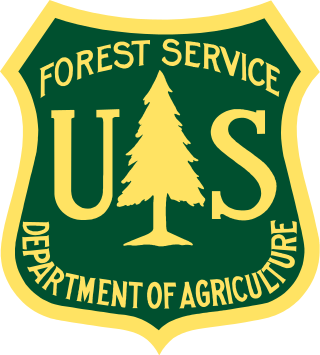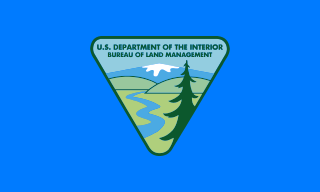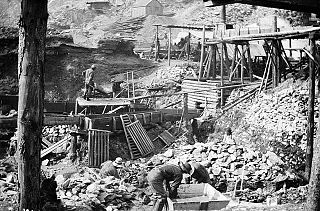Related Research Articles

The United States Forest Service (USFS) is an agency within the U.S. Department of Agriculture that administers the nation's 154 national forests and 20 national grasslands covering 193 million acres (780,000 km2) of land. The major divisions of the agency are the Chief's Office, National Forest System, State and Private Forestry, Business Operations, as well as Research and Development. The agency manages about 25% of federal lands and is the sole major national land management agency not part of the U.S. Department of the Interior.

The Bureau of Land Management (BLM) is an agency within the United States Department of the Interior responsible for administering U.S. federal lands. Headquartered in Washington, D.C., the BLM oversees more than 247.3 million acres (1,001,000 km2) of land, or one-eighth of the United States's total landmass.

The United States Department of the Interior (DOI) is an executive department of the U.S. federal government responsible for the management and conservation of most federal lands and natural resources. It also administers programs relating to Native Americans, Alaska Natives, Native Hawaiians, territorial affairs, and insular areas of the United States, as well as programs related to historic preservation. About 75% of federal public land is managed by the department, with most of the remainder managed by the Department of Agriculture's Forest Service. The department was created on March 3, 1849. It is headquartered at the Main Interior Building, located at 1849 C Street NW in Washington, D.C.

The United States Senate Committee on Energy and Natural Resources is a standing committee of the United States Senate. It has jurisdiction over matters related to energy and mineral resources, including nuclear development; irrigation and reclamation, territorial possessions of the United States, trust lands appertaining to America's indigenous peoples, and the conservation, use, and disposition of federal lands. Its roots go back to the Committee on Interior and Insulars Affairs. In 1977, it became the Committee on Energy and Natural Resources, and most matters regarding Native Americans, Alaska Natives, and Native Hawaiians were removed from its jurisdiction and transferred to the Committee on Indian Affairs.

The Southern Utah Wilderness Alliance(SUWA) is a wilderness preservation organization in the United States based in Salt Lake City, Utah, with field offices in Washington, D.C. and Moab, Utah. The organization formed in 1983 and is a partner in the Utah Wilderness Coalition, a coalition of organizations nationwide that support federal wilderness designation for deserving public lands in Utah.

The Federal Land Policy and Management Act (FLPMA) is a United States federal law that governs the way in which the public lands administered by the Bureau of Land Management are managed. The law was enacted in 1976 by the 94th Congress and is found in the United States Code under Title 43. The Federal Land Policy and Management Act phased out homesteading in the United States by repealing the pre-existing Homestead Acts.
The California Department of Conservation is a department within the government of California, belonging to the California Natural Resources Agency. With a team of scientists, engineers, environmental experts, and other specialists, the Department of Conservation administers a variety of programs vital to California's public safety, environment and economy. The department's mission is to manage California's working lands. It regulates oil, natural gas and geothermal wells; studies and maps earthquakes and other geologic phenomena; maps and classifies areas containing mineral deposits; ensures reclamation of land used for mining; and administers agricultural and open-space land conservation programs. A division within the department dedicated to encouraging beverage container recycling has been moved into the newly created Department of Resources Recovery and Recycling (CalRecycle). Despite the similar name, the Department of Conservation should not be confused with the California Conservation Corps, another department within the Natural Resources Agency, which provides work experience for young adults. The Department of Conservation often collaborates with its federal equivalents, such as the U.S. Geological Survey.

Hog Island is an uninhabited island located off the eastern shore of Washington Island in the town of Washington, Door County, Wisconsin, United States. The island has a land area of 2.14 acres (8,656 m2) and an elevation of 10 feet or 20 feet above Lake Michigan.
The United States Senate Energy and Natural Resources Subcommittee on Public Lands and Forests is one of four subcommittees of the U.S. Senate Energy and Natural Resources Committee.

Norman Irving Wengert was an American political scientist who wrote about the politics of natural resources, advanced a seminal theory of the "politics of getting", and had a number of significant roles in his public and academic career. He was born in Milwaukee, Wisconsin to Eugene F. and Lydia Semmann Wengert. He pioneered the revival of the study of political economy in the United States with publication of Natural Resources and the Political Struggle, and later authored more than fifty monographs and studies on the political economy and public administration of environmental resources. His scholarship explored the politics of natural resources and environmental policy formation and administration, with emphases in national energy policy, urban water planning and management, land use planning and controls, national forest management, and citizen participation in administrative processes.

Susan Elizabeth "Liz" Birnbaum served as Director of the Minerals Management Service in the United States from July 15, 2009, to May 27, 2010. Birnbaum was in charge of administering "programs that ensure the effective management of renewable energy [...] and traditional energy and mineral resources on the nation's Outer Continental Shelf, including the environmentally safe exploration, development, and production of oil and natural gas, as well as the collection and distribution of revenues for minerals developed on federal and American Indian lands."
The Foundation for Natural Resources and Energy Law, formerly Rocky Mountain Mineral Law Foundation, is an educational, non-profit organization dedicated to the scholarly and practical study of all aspects of natural resources and energy law.

The Three Kids Mine Remediation and Reclamation Act is a U.S. public law that authorizes the sale of approximately 950 acres of federal land to the city of Henderson, Nevada. The land used to be a mine and now needs significant environmental remediation and reclamation. The bill was introduced into the United States House of Representatives during the 113th United States Congress; a previous version passed the House during the 112th United States Congress, but never received a vote in the Senate. Cleanup efforts of the land are expected to cost between $300 million and $1.2 billion, depending on various estimates and cleanup targets.

The Southeast Arizona Land Exchange and Conservation Act of 2013 is a bill that was introduced into the United States House of Representatives during the 113th United States Congress. H.R. 687 would authorize a land exchange in Arizona between the federal government and a mining company. Under H.R. 687, the United States Forest Service would convey about 2,400 acres of land in southeast Arizona to Resolution Copper Mining LLC in exchange for about 5,400 acres of company-owned land. Of the company land, about 1,200 acres would become part of the National Forest System, and about 4,200 acres would be administered as conservation areas by the Bureau of Land Management. If the property sought by Resolution Copper is appraised at more than the appraised value of the property that the company offers for exchange, the company could donate additional land or make a cash payment to the United States to make the final exchange of equal value. If the company’s property is appraised for more than the federal acreage, the difference in the value would be considered a donation to the federal government. According to the Committee Report on the bill, the "mine could provide up to one-quarter of the nation's estimated annual copper needs" and the mining company estimates that the "total economic impact of the mine will exceed $60 billion and support 3,700 jobs annually." Opponents of the bill argue that the swap has not been thoroughly studied, that the mining company has failed to indicate where it will get much needed water for the mine, and that Native American tribes have not been properly consulted.

The Federal Lands Jobs and Energy Security Act is a bill that would require the Bureau of Land Management (BLM) to establish certain fees for activities related to the development of oil and gas on federal lands. A portion of those amounts along with a portion of fees from renewable energy projects on federal lands would be available to the agency, subject to appropriation, to cover the costs of activities aimed at increasing energy development on federal lands. The bill also would exempt lawsuits related to energy production on federal lands from the Equal Access to Justice Act (EAJA). In addition, the legislation would require the BLM to offer for sale at least 25 percent of onshore federal lands nominated by firms for oil and gas leasing. It was introduced in the United States House of Representatives during the 113th United States Congress. President Barack Obama threatened to veto the bill on November 19, 2013.

The Stewardship Contracting Reauthorization and Improvement Act was a bill introduced in the 113th Congress by U.S. Senator Jeff Flake. The bill would have given the federal government more authority to enter into what are known as "forest stewardship contracts", with the goal of reducing the risk of forest wildfires.

Pub. L.Tooltip Public Law 113–127 (text)(PDF) is a United States public law that would take specified federal land in El Dorado County, California, into trust for the Shingle Springs Band of Miwok Indians. The United States Secretary of the Interior would be responsible for carrying this out.

The Soledad Canyon Sand and Gravel Mining Project is a mining project in Northern Los Angeles County east of the city of Santa Clarita, California, United States. First mined in 1921, the property was mined by Curtis Sand and Gravel from the early 1960s until 1989, when, as a result of a legal settlement, the Bureau of Land Management put two 10-year leases to mine sand and gravel from the site out to competitive bid. The contracts were awarded to Transit Mixed Concrete, which eventually sold them to Cemex Corporation.
Gregg Renkes is an American politician, attorney, and lobbyist who served as the Alaska Attorney General from 2002 to 2005.
References
- 1 2 United States Congress Senate Committee on Interior and Insular Affairs Subcommittee on Public Lands (1963). Public Land Review: Hearings Before the United States Senate Committee on Interior and Insular Affairs, Subcommittee on Public Lands, Eighty-Eighth Congress, First Session, on May 6-7, Aug. 6, 1963. U.S. Government Printing Office.
- ↑ "Board Proposed On Land Appeals", Arizona Daily Star (February 13, 1963), p. 6.
- ↑ "Western Solons Meet Roadblock In Effort To Change Land Policy", The Roseburg News-Review (May 6, 1963), p. 2.
- ↑ David L. Hughes, Practice and Procedure before the Interior Board of Land Appeals 14 Pub. Land L. Rev. 113 (June 1993), p. 115-116.
- 1 2 3 "About the Interior Board of Land Appeals". United States Department of the Interior . Retrieved July 15, 2021.
 This article incorporates text from this source, which is in the public domain .
This article incorporates text from this source, which is in the public domain . - ↑ "Interior Board of Land Appeals | Open Energy Information". openei.org. Retrieved 2021-10-13.